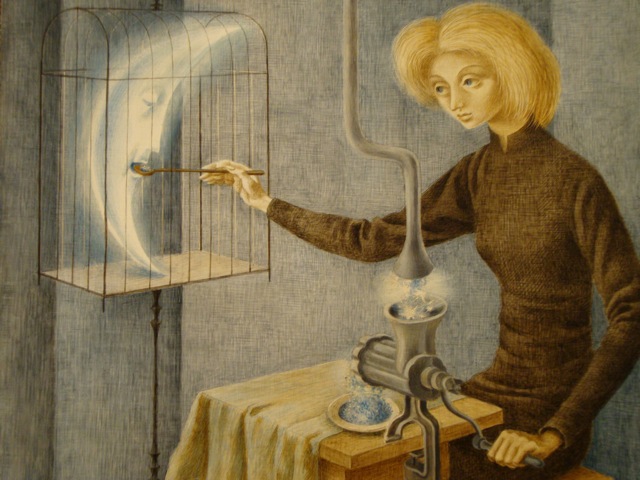Currently at LACMA is a magnificent group show that features the subconscious dreamworld of female Surrealist artists. The material is mainly drawn from the period between 1931 to 1968, in a variety of media, and showcases quite a few of the big names - Frida Kahlo and Louise Bourgeois are probably the two most well-known exhibitors. But what is most enjoyable about this show is discovering the lesser-knowns. It's truly overwhelming the amount of work on display, and with most works so heavy with iconography and deep symbology, it's probably an exhibition you need to devote a lot of time to, or do in two visits. I think I barely absorbed a third of the collection, and my eyes were drawn to the work of two particular artists - Dorothea Tanning and Remedios Varo.
Tanning, was born in 1910 in Illinois to a middle-class life, but aspired to be involved in the art world. She moved to New York in 1936, and it was here that she was awakened to her love for the new artform when she saw the MOMA “Fantastic Art, Dada, Surrealism” exhibition. Her life's work ranges in style quite dramatically - from precisely detailed paintings to soft sewn sculptural figures. Largely self taught, Tanning's first solo show was in New York in 1944. But large parts of her life were also spent in Europe with her husband, German artist Max Ernst, where she also exhibited regularly.
 |
| Dorothea Tanning, "The Game Of Chess", 1944, oil on canvas. |
 |
| Dorothea Tanning, "Portrait de Famille", 1954, oil on canvas. |
 |
| Dorothea Tanning, "Reve (Dream)", 1944, oil on canvas. |
Spanish painter Remedios Varo's work is truly mystical. Born in 1908, Varo arrived in Mexico in 1941 after an educative period in Paris where she honed her skills. But it was in the 1950's that her unique technique was further refined. Working mostly with oil on masonite, her esoteric compositions are rendered with the finest of layered brushstrokes. It's mesmerizing work to see in the flesh, and I witnessed many other gallery visitors becoming spellbound by her pieces. Her interests in alchemy and sacred geometry are strongly displayed in her work, along with a message of transformation and the power of self-enlightenment.
 |
| Remedios Varo, "Papilla estelar", 1958, oil on masonite. |
 |
| Remedios Varo, "La huida (The Escape)", 1961, oil on masonite. |
 |
| Remedios Varo, "Woman Departing from the Psychoanalyst's Office", 1960, oil on canvas. |
 |
| Remedios Varo, Creation of the Birds", 1958, oil on masonite. |
 |
| Remedios Varo, "Armonia (Harmony)", 1956, oil on masonite. |
Beyond the hyper-detailed images of Tanning and Varo, there were many other pieces I was inspired by. Drawing, collage, photography, sculpture - many methods are represented at this show displaying the inner world of emotions and the imagination, and the more socially political outer world. For example, Kay Sage, who directly assisted displaced European intellectuals, used her work to convey the destruction of the continent from years of war, through her barren landscape paintings.
 |
| Kay Sage, "Danger, Construction Ahead", 1940, oil on canvas. |
|
 |
| Dorr Bothwell, "Stag's Heart", 1946, collage. |
 |
| Julia Thecla, "In The Book She Reads", 1961, charcoal, pastel and graphite on paper. Produced after imprinting paper with carbon/smoke from a candle flame, considered to help release the subconscious mind. |
 |
| Rosa Rolanda, "Self-Portrait", 1952, oil on canvas. |
 |
| Sylvia Fein, "The Lady Magician", 1954, egg tempera on masonite. |
 |
| Helen Lundeberg, "Self-Portait (With Landscape)", 1944, oil on masonite. |
"In Wonderland" is on show until May 6th, 2012, here in Los Angeles, and is a proud celebration of intellectual freedom and self-discovery beyond gender stereotypes. Thank goodness for these extraordinary women.




















